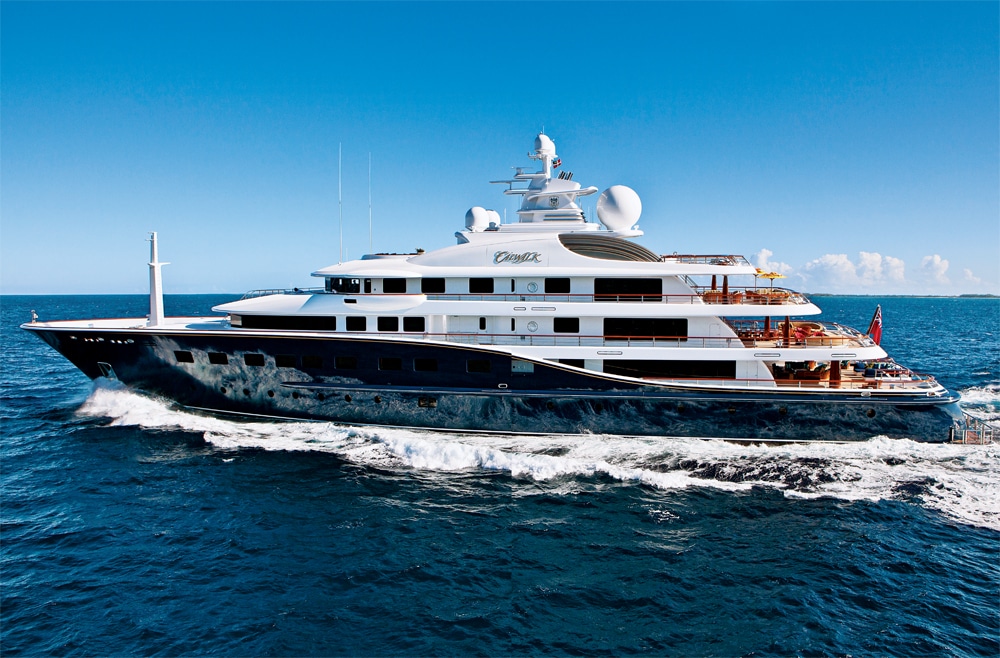
Cakewalk
“Can’t we do it in the United States?”
That was the overriding thought in the heads of an American owner and his captain, Bill Zinser, when they began laying groundwork for a new yacht seven years ago. The duo had bought, refitted and/or commissioned four megayachts already, so they were well versed in what they wanted and needed. Surely a U.S. yard could build it — couldn’t it?
The prevailing wisdom throughout the 1990s held otherwise. Only European shipyards could deliver a project of the magnitude they were considering, closing in on 3,000 gross tons. In classic American style, however, the owner and his captain remained optimistic.
It paid off: The result is the 281-foot Cakewalk, the largest yacht by volume built on American soil, and the second-largest by length built stateside since the 343-foot Corsair IV in 1930. Furthermore, this build brought the skills of a quiet New England shipyard to global attention.
That shipyard is Derecktor Shipyards, based in Bridgeport, Connecticut, long run by a family that prefers focusing on the work at hand to seeking the limelight. As the “Shipyards” part of the name implies, Derecktor has other facilities — in Mamaroneck, New York, and Dania, Florida. Derecktor Florida had actually refitted a previous Cakewalk, originally built by Feadship as Fiffanella, adding 10 feet to her 132-foot overall length. It became one of the largest refits of the mid-1990s. Zinser and the owner were pleased with the work, so naturally Derecktor Shipyards ended up on their short list for the new project.
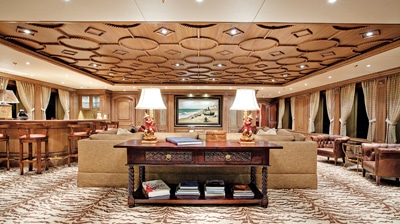
(For more photos, click here).
While Zinser and the owner were doing their homework, so was Derecktor. Hugo van Wieringen, the director of Azure Naval Architects, was approached by Paul Derecktor, president of the yard. Paul Derecktor explained that he’d like Derecktor Connecticut, known for its ferries and other commercial projects, to take on more yachts. He proposed teaming with Azure Naval Architects on a few designs and builds. Coincidentally, “quite soon after that, I met with Bill Zinser and learned that the owner wanted to build a bigger yacht, and preferably in the USA,” van Wieringen says. (He knew Zinser and the owner from his days in the De Voogt Naval Architects office of Feadship prior to setting up his own shop.) Introductions were made all around at the 2005 Monaco Yacht Show.
Zinser grew up in Connecticut and knew of the Bridgeport facility. When he paid a visit, he was confident it had “the commercial mentality,” as he put it, to undertake the contract. “You need big everything” for a yacht of this scale, he adds, particularly in terms of structure. Even though he recognized there’d be a “big learning curve” for the yard, “I was never worried about the metal-structure construction,” Zinser says. At least nine U.S. Coast Guard cutters measuring nearly the same length as the new Cakewalk had come out of Derecktor Connecticut. In addition, it had built two 240-foot high-speed car ferries for the state of Alaska. Derecktor “had a substantial amount of experience in large steel vessel construction,” Zinser explains. “With the company’s enthusiasm and the daily participation of our team to control and assist in all directions, we believed that we could build the perfect Cakewalk in the USA.”
This enthusiasm and team effort were key to the project’s success. Speak with a few yacht owners and their representatives, and you’ll learn of shipyards that insist on doing things the way they’ve always done them. Not the case with Cakewalk. “Derecktor listened,” Zinser stresses. Often, he adds, the conversations went along the lines of, “We’ve done [things this way], but what do you have in mind?”
The craftsmen also had the right attitude to meet the high level of finish demanded by a yacht — and this yacht in particular. The owner and Zinser had taken a strong liking to the signature style of Tim Heywood, having seen his bold curves in the profile of the 305-foot Carinthia VII. Derecktor New York was tasked with building the aluminum superstructure, but even the skills they’d demonstrated in constructing and restoring America’s Cup competitors were challenged by Heywood’s intricate design. Kathy Kennedy, Derecktor’s marketing director, puts it this way: “Tim Heywood curves are not easy.” Heywood is the first to agree: “Unfortunately, my designs tend to be a bit complex,” he says, somewhat sheepishly. But, he backs up Kennedy’s assertion that “Tim Heywood said we followed his design perfectly.” Specifically, he says, “The strength of line of the exterior is something I’m really, really pleased with.”
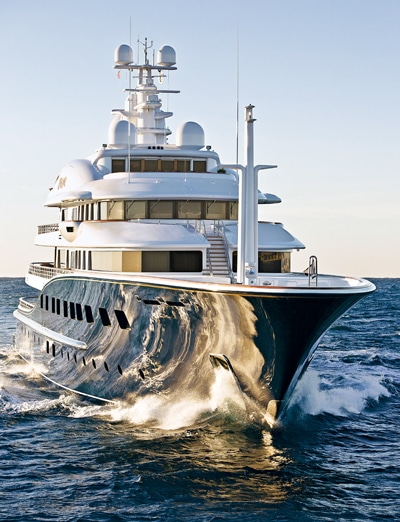
Heywood, as well as Zinser and the owner, are also pleased with the execution of the boathouse, otherwise known as the tender garage. It needed to be large enough to hold three custom tenders, several PWCs and a few other water toys, plus meet Lloyd’s and SOLAS (Safety of Life at Sea) standards. Measuring 47 feet by 40 feet, it houses two overhead cranes that slide out about 10 feet. Each can launch and retrieve a classic limited-edition Riva Aquariva 100 Cento, an Intrepid Custom 350 Open and a Vikal limo tender designed by Heywood to match Cakewalk. The tenders sit in custom-built cradles, and Derecktor also constructed the electric/hydraulic side doors, designed by Freeman Marine, through which they depart and return.
Just as much attention was paid to the general arrangement of the interior. “They got how [the owners] like to live,” Kennedy explains. Entertaining is a priority, as is chartering, so the galley spans three decks, all tucked to port. Most of the cooking takes place on the main deck, as you’d expect, and a good-size pantry allows the stewardesses to stage platters and exit and enter the dining room without getting in each other’s way. But the owner’s deck, one level up, plus the bridge deck above that feature additional pantries, which really are akin to extra galleys. They contain microwaves and other appliances, plus far more counter space than the primary galleys aboard most other megayachts — even ones in the same size range.
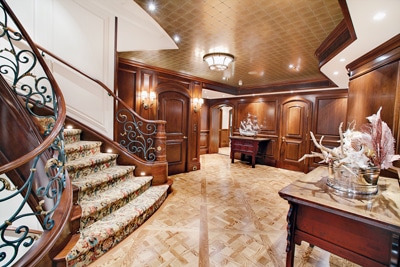
They’re all steps away from rooms that will get significant use, whether the owner and his family are aboard or charter guests have booked Cakewalk. The main-deck salon is fashioned as a library, with a majestic fireplace amidships. Up one deck, “the owner’s salon is really cool — it’s got a lot of jazz to it,” says Liz Dalton, the owner’s longtime interior designer. Rather than looking around the room, guests should really look up: Ropelike circles repeat across the overhead. All the joinery in the salon was executed by Merritt Woodwork, an Ohio-based firm. (Yet another American firm, Zepsa Architectural Woodwork, took on the joinery on the main and bridge decks, with Derecktor New York completing the teak cap rails and decks.) The bridge-deck lounge has the most casual atmosphere, with shutter-like blinds, a card table and seating situated in front of the TV.
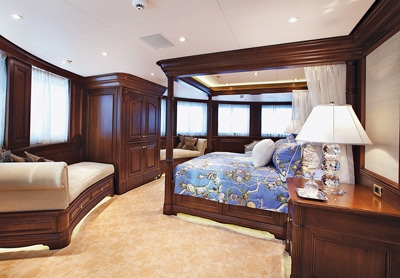
Even with their distinctly different looks, the three primary lounges, as well as other gathering areas, are all in proportion. Nowhere do you feel as if you’re aboard a sprawling ship. That’s a feat unto itself, considering that everything about Cakewalk is huge. Her beam is nearly 47 feet. She rises six decks high. She employs a 400 kW bow thruster. Two of her four main gensets are MTU 12-volt 2000 M40Bs, more commonly found aboard ferries.
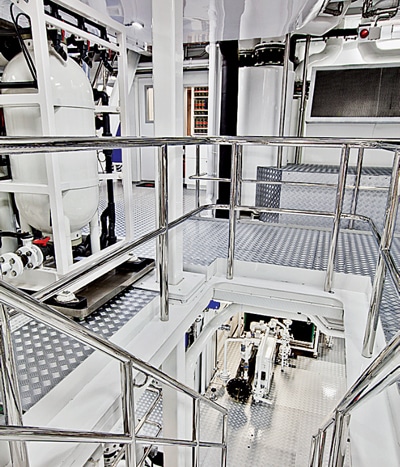
Nor was she easy to build. “Needless to say, as with any project of this scale and sophistication, there were some growing pains along the way,” Paul Derecktor says, “but we think the result speaks for herself.” Indeed, the design and build teams speak highly of one another and of what has been accomplished. “I cannot say anything less than that the owner and captain are a very experienced, close team with the utmost dedication to building a perfect boat as well as to fully enjoying cruising the world,” van Wieringen says. “Their determination to get things right is tremendous.” Zinser sums it up this way: “I think we’ve exceeded the quality I’m accustomed to.” As for Derecktor, he believes that “Cakewalk is a new benchmark for American-built yachts.” Heywood agrees: “It’s an enormous feather in the yard’s cap to say, ‘This is what we have done. There are thousands of shipyards that will tell you what they can do, but this is what we have done.'”
And it was all done right here, in the United States.
LOA: 281’0″
Beam: 46’9″
Draft: 13’1″
Displ.: 2,998 tons
Fuel: 97,000 gal.
Water: 8,454 gal.
Construction: Steel
Design: Azure Naval Architects, Tim Heywood Design
Interior Design: Dalton Designs
Generators: 2 x 660 kW MTU 12V 2000 M40B, 2 x 350 kW MTU S60 550 and 1 x 275 kW MTU S60 400
Bow Thruster: Jastram
Watermaker: HEM, 8,421 gpd
Engines: 2 x 3,306 hp MTU 16V 4000 M71 diesels
Speed: 17 knots max, 15 knots cruise
Range: 5,000 miles at 15 knots
Derecktor Shipyards, 800-691-2100; www.derecktor.com
_View a complete gallery of Cakewalk._**
**
**Icing on the Cakewalk
**A special boat deserves special tenders.
Cakewalk totes a variety of toys and tenders. A 34-foot Intrepid is aboard, for example — excellent for towing skiers, exploring coastlines or indulging guest anglers. Yamaha PWCs, Seabob water sleds, kneeboards, sea kayaks and other gear keep smiles on the faces of a variety of guests. But two of Cakewalk‘s tenders truly stand out from the rest.
The 37-foot Vikal, custom-designed by Tim Heywood to complement Cakewalk, sports a deep-blue hull. As luxurious as its mothership, there’s plush seating inside the cabin and at the bow. Performance-wise, it’s more akin to a race car than a limo: it has a top speed of 50 knots, thanks to twin 370-horsepower Volvo Penta D6 turbocharged engines.
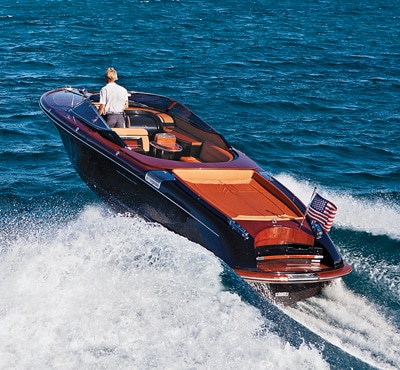
The Riva Aquariva 100 Centro is hull number 9 of only 10 made to celebrate the 100th unit of the Aquariva line. The nearly 33-footer sports the high-gloss wood of the famed Italian runabouts but guests should hold onto their champagne: Twin 370-horsepower Yanmar engines push it to 42 knots.**
**
Subscribe to the Yachting Life newsletter for cruising and chartering guides, new boat announcements, event updates, special offers and more!









